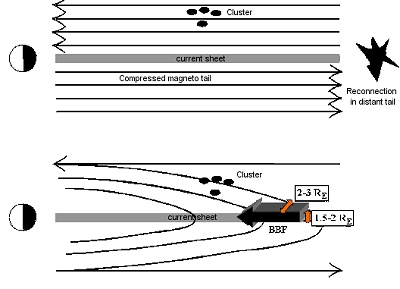Spatial scale of high-speed flows in the magnetotail
13 December 2004
High-speed flows of plasma, propagating from the magnetotail to the Earth at velocities higher than 300 kms-1, are the carriers of decisive amounts of mass, energy and magnetic flux. Published 7 may 2004, in Geophysical Research Letters, a statistical study based on multipoint measurements by the Cluster mission reveals, for the first time, their typical spatial scale.
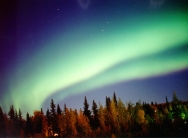 |
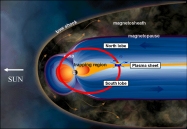 |
|
Image 1: Northern lights |
Image 2: Sketch of the Earth's magnetosphere (Copyright: ESA) |
Even before the space age, observers noted that in the arctic winter, when the sky is dark most of the time, the brightest auroras (Image 1) were seen in the hours around midnight. At this time, it was widely believed that energetic electrons, responsible for the auroras, came from the Sun. The fact that aurora seemed concentrated on the side facing away from the Sun puzzled everyone.
Satellite observations revealed that, at the nightside of the Earth, the magnetospheric tail is composed of three main regions (Image 2): a "plasma sheet" centred on the equator, with a weak magnetic field and a typical density of ~0.5 particles per cc; and two tail lobes regions located north and south of the plasma sheet with a very low density of ~0.01 particles per cc but with a more intense magnetic field. Because of the weak magnetic field of the plasma sheet, ions and especially electrons were observed to leak out, in particular towards the Earth.
But if the plasma creating the northern lights originates from the plasma sheet, new ions and electrons must arrive to take its place, or else the plasma sheet would soon be drained and the extended tail field would quickly collapse. So how is fresh plasma supplied?
In the 50's, James Dungey's theory of magnetic reconnection suggested an answer to this issue, and Animation 1 illustrates it.
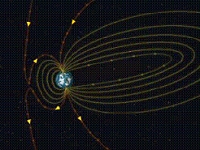 |
|
Animation 1: Global view of magnetic reconnection (Copyright: NASA). |
The Sun is located on the left, out of the scope of the animation. As the animation begins, we see magnetic field lines (yellow lines) and arrows moving around the Earth's magnetosphere, showing how our magnetic field is naturally oriented to the north: the field flows out of the south pole and into the north.
The animation then depicts how the Interplanetary Magnetic Field (IMF) interacts with the Earth's magnetic field: first when the IMF is pointing north, then when it points south.
The IMF, carried by the solar wind (see November 2004 Cluster top story on "Four-point observations of solar wind discontinuities"), is symbolised by a red line; more precisely, only the Bz component is represented here.
When the IMF is oriented to the north (arrows pointing up), the IMF cannot connect to our magnetic field on the dayside. In this case, the solar wind flows around the magnetosphere.
But when the IMF is oriented southward (arrows pointing down), magnetic reconnection occurs as the IMF can connect to the Earth's northward magnetic field (orange field lines). The solar wind then drags the reconnected field lines from the dayside to the nightside, allowing the plasma to pour into the tail of the magnetosphere. This drag stretches the field lines, and stores the energy in the form of magnetic tension.
As the field lines pile up on the nightside, the system becomes unstable. Reconnection happens again, this time in the middle of the tail (a phenomenon associated with substorm): the newly open magnetic field lines reconnect to form closed field lines, which return back to the Earth. When this occurs, stored particles and energy are released both earthward and tailward. These phenomena energize ions and electrons, inject some of them into the ring current, and greatly increase the rate at which energy is released in the magnetosphere, which, in particular, produce auroras.
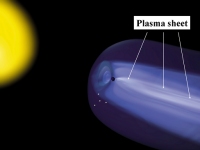 |
|
Animation 2: Full orbit of the Cluster space fleet over a simulated Earth's magnetosphere responding to the Sun's activity (Copyright: ESA) |
Dungey's theory of magnetic reconnection is nowadays widely accepted by the scientific community, in particular to describe the overall picture of the IMF interaction with the Earth's magnetosphere. However, understanding (in order to forecast) the plasmasheet dynamics (e.g. occurrence of substorms, their location) and their impact at geostationary orbit, in the ionosphere, the atmosphere and on the ground is an on-going active worldwide research effort, involving many satellite missions and ground-based experiments.
The Cluster quartet of satellites, launched in summer 2000, allows, for the first time, to separate spatial and temporal variations. This is of particular importance in a highly variable and dynamic region like the Earth's magnetotail and provides completely new insight into magnetotail dynamics [Baumjohann and Nakamura, 2004].
Using this unique multipoint measurements capability, a recent statistical study focused on the determination of the spatial scale of the most dynamic events occurring in the Central part of the Plasma Sheet (CPS): the transient high-speed plasma flows (> 300 kms-1), or Bursty Bulk Flows (BBF).
Discovered at the end of the 80's, such flows are spatially and temporally limited, typically lasting about 10 minutes and being composed of minute-long bursts. Despite their short duration, BBF are the carriers of decisive amounts of mass, energy and magnetic flux. In other words, BBF can stir plasma very efficiently from the plasmasheet.
Possible mechanisms have already been proposed and numerical simulations developed to explain this phenomenon. However, both theoretical models and numerical simulations obviously require an accurate estimate of the BBF typical spatial scale to quantitatively describe this phenomenon. This spatial extent is composed of 3 dimensions: the dawn-dusk, the north-south and the "Sun-Earth direction" scale size. The latter can be easily estimated knowing the typical duration and the velocity of BBF.
BBF are observed in the CPS, which has a typical north-south thickness of 6 RE (1 RE = 6378 km - the Earth's equatorial radius) in the midnight sector. The north-south extent of BBF is therefore expected to be smaller than 6 RE.
Past comparisons of single spacecraft measurements with ground-based data led to the conclusion that their dawn-dusk extent is limited to 3-5 RE. Two-spacecraft observations led to a different conclusion: 1-3 RE.
A recent study challenged these results by using measurements from the Cluster mission to estimate the spatial scale of BBF [Nakamura et al., 2004].
Between July and October 2001, the Cluster spacecraft were flying in the magnetotail Earthward of 19 RE, where predominantly Earthward fast flows were detected (>75%). Focusing on more than 1600 data points of Earthward flow events observed by Cluster, Nakamura et al. (2004) conducted a statistical analysis to estimate
- the north-south typical scale size of BBF
- the dawn-dusk typical scale size of BBF
- the velocity gradient at the duskward and dawnward edge of the BBF
"Multipoint observations from the Cluster spacecraft suggest that the full width of the flow channel is on average 2–3 RE in the dawn-dusk direction and 1.5–2 RE in the north-south direction" (Image 3), wrote Dr. Rumi Nakamura, lead author on this research, published 7 May 2004 in Geophysical Research Letters.
"The velocity gradient at the duskward edge of a flow tends to be sharper than that at the dawnward edge, possibly reflecting an asymmetry in the magnetosphere-ionosphere coupling process associated with the flow", she added.
Dr. Rumi Nakamura is the lead scientist of the Cluster data analysis team at the Space Research Institute/Austrian Academy of Sciences, Graz and Co-Investigator of the Cluster Ion Spectrometry instrument (CIS), the Electron Drift Instrument (EDI) and the FluxGate Magnetometer (FGM). The instruments used for this statistical study are the Composition and Distribution Function Analyser (CODIF) of CIS and FGM.
This new result is far from being the only one found by Cluster in the Earth's magnetotail related to BBF. Over the past 4 years, Cluster has indeed significantly enhanced our knowledge on how many of the dynamic processes in the magnetotail are often related to BBF, including: strong wave activity [Volwerk et al., 2003b, 2004a, 2004b], turbulence [Vörös et al., 2003, 2004], reconnection [Runov et al., 2003] and the thinning of the current sheet [Nakamura et al., 2002; Asano et al., 2004].
Describing every above mentioned article is beyond the scope of this webstory. However, as an example, a recent article by Dr Martin Volwerk [Volwerk et al., 2004c], published 11 November 2004 in the Journal of Geophysical Research, presents important evidence that BBF, related to reconnection farther down in the tail, could result in a large-scale, damped oscillation of the plasma sheet as follows: BBF observed in this case study first empty the whole inner region of the magnetotail of its magnetic field (inner with respect to the neutral sheet). This emptied out tail situation, where plasma pressure takes over from magnetic pressure, is unstable. The magnetic field wants to return, and thus sets the whole tail into a large-scale damped oscillation.
In the near future, the analysis of Cluster measurements at all separation scales from 100 km to 5000 km, and 10000 km next year, shall further illuminate our knowledge on the Earth's magnetotail dynamics.
Nakamura, R., W. Baumjohann, C. Mouilis, L. M. Kistler, A. Runov, M. Volwerk, Y. Asano, Z Vörös, T. L. Zhang, B. Klecker, H. Rème, and A. Balogh (2004), Spatial scale of high-speed flows in the plasma sheet observed by Cluster, Geophys. Res. Lett., 31, L09804, doi:10.1029/2004GL019558.
Volwerk, M., K.-H. Glassmeier, A. Runov, R. Nakamura, W. Baumjohann, B. Klecker, I. Richter, A. Balogh, H. Rème, and K. Yumoto, Flow burst–induced large-scale plasma sheet oscillation (2004c), J. Geophys. Res., 109, A11208, doi:10.1029/2004JA010533.
Baumjohann, W., and R. Nakamura, What is Cluster telling us about magnetotail dynamics?, Adv. Space Res., in press, 2004.
Related articles
Asano, Y., R. Nakamura, W. Baumjohann, A. Runov, Z. Voros, M. Volwerk, and T. L. Zhang (2004), How typical are atypical current sheets?, Geophys. Res. Lett., in press.
Nakamura, R., W. Baumjohann, A. Runov, M. Volwerk, T. L. Zhang, B. Klecker, Y. Bogdanova, A. Roux, A. Balogh, H. Rème, J. A. Sauvaud, H.U. Frey (2002), Fast Flow during current sheet thinning. Geophys. Res. Lett., 29, 2140, doi:10.1029/2002GL016200.
Runov, A., R. Nakamura, W. Baumjohann, T. L. Zhang, M. Volwerk, and H.-U. Eichelberger (2003), Cluster observation of a bifurcated current sheet, Geophys. Res. Lett., 30(2), 1036, doi:10.1029/2002GL016136, 2003.
Volwerk, M., et al. (2004b), Multi-scale analysis of turbulence in the Earth's current sheet, Ann. Geophys., 22, 2525– 2533.
Volwerk, M., et al. (2004a), Compressional waves in the Earth's neutral sheet, Ann. Geophys., 22, 303– 315.
Volwerk, M., et al. (2003b), A statistical study of compressional waves in the tail current sheet, J. Geophys. Res., 108(A12), 1429, doi:10.1029/2003JA010155.
Vörös, Z., W. Baumjohann, R. Nakamura, A. Runov, M. Volwerk, and T. L. Zhang (2004), Wavelet analysis of magnetic turbulence in the Earth's plasma sheet, Phys. Plasmas, 11, 1333– 1338.
Vörös, Z., et al. (2003), Multi-scale magnetic field intermittence in the plasma sheet, Ann. Geophys., 21, 1955– 1964.
Related websites
http://www-istp.gsfc.nasa.gov/http://www.northern-lights.no/
Contacts
Rumi Nakamura, Institut für Weltraumforschung der ÖAW, Graz, Austria.Tel: +43-316-4120-573
Martin Volwerk, Institut für Weltraumforschung der ÖAW, Graz, Austria.
Tel: +43-316-4120-575
Web story author
Arnaud Masson, SCI-SH division, RSSD, ESA, The Netherlands.
Tel: +31-71-565-5634
Web story editor
Philippe Escoubet, SCI-SH division RSSD, ESA, The Netherlands.
Tel: +31-71-565-3454

